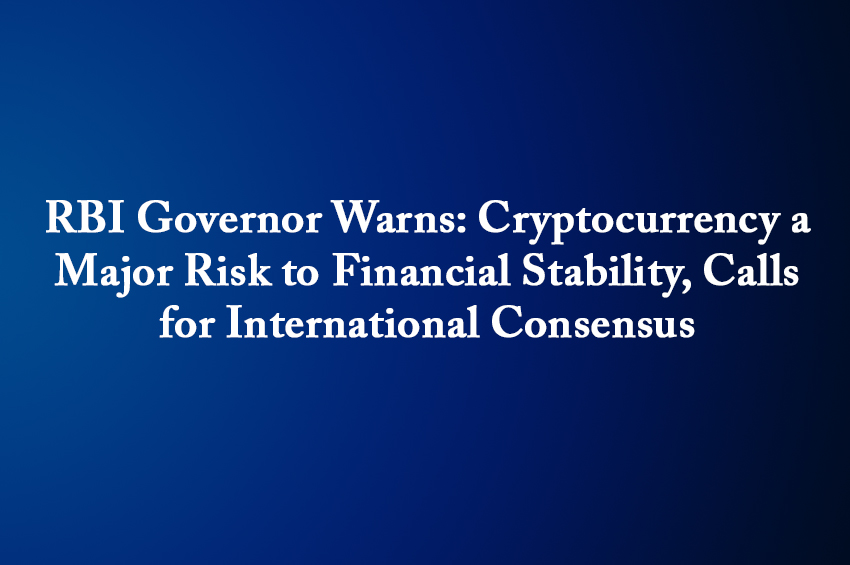Winning Bizness Desk
Mumbai. In a speech at the Peterson Institute for International Economics, Reserve Bank of India (RBI) Governor Shaktikanta Das highlighted the risks that cryptocurrency poses to global financial stability. He emphasized that, unlike other financial innovations, cryptocurrencies threaten the core functioning of the banking and monetary systems. India, he noted, was among the first countries to raise these concerns, signaling a growing need for international collaboration to mitigate these risks effectively.
Governor Das expressed his belief that cryptocurrencies should not be allowed to interfere with the financial system’s operations, as they jeopardize both financial and monetary stability. A primary concern, he explained, is the potential loss of control over money supply if cryptocurrencies become widespread, rendering central banks powerless in times of economic instability. For instance, in cases where inflation spikes or liquidity issues arise, central banks typically rely on adjusting the money supply to maintain economic stability. However, with cryptocurrencies operating beyond this control, central banks may find it challenging to intervene effectively, raising the risk of economic instability.
Cross-Border Risks and the Need for Global Consensus
Cryptocurrency transactions often transcend national borders, posing unique challenges for individual governments and central banks. Das argued that this cross-border nature necessitates a global understanding to address the associated risks comprehensively. He reiterated that India has been at the forefront of these discussions, notably during its G-20 presidency. Under India’s leadership, G-20 members agreed to develop a collective approach to manage the crypto ecosystem, marking a significant step toward achieving international consensus on regulation.
Cryptocurrency’s Origins and the Threat of a Parallel Currency System
Das further discussed the origins of cryptocurrency, pointing out that it was designed to operate outside traditional financial systems. Cryptocurrencies exhibit many properties of traditional currencies but lack the regulatory backing of central banks. This has raised fundamental questions about the implications of allowing privately issued digital currencies to exist alongside fiat currencies. He posed the critical question of whether governments and financial authorities should feel comfortable with a private, unregulated currency system operating parallel to official fiat currencies.
Das warned that if a segment of the economy begins relying on cryptocurrency or similar private assets, it could undermine the central bank’s control over the monetary system. This shift could generate unprecedented instability in both monetary and financial sectors. The governor stressed that, given the high risks involved, regulatory authorities must approach cryptocurrency with caution.
India’s Stance and Regulatory Approach
India has consistently taken a cautious approach to cryptocurrency, recognizing its potential to disrupt financial systems. Das highlighted that the Reserve Bank of India was one of the earliest central banks to voice serious concerns regarding cryptocurrencies, urging for clear, stringent measures to manage these risks. India’s leadership in the G-20 discussions on crypto regulation reflects this proactive stance, aiming to foster a regulatory framework that addresses these risks internationally.
Understanding Cryptocurrency: History and Function
Cryptocurrency is a form of digital or virtual currency that facilitates transactions in a decentralized manner, much like fiat currencies such as the dollar or rupee. Bitcoin, the first and most popular cryptocurrency, emerged in 2009, introduced by the pseudonymous creator Satoshi Nakamoto. Transactions in bitcoin are recorded on a public blockchain, an immutable, decentralized ledger maintained collectively by network participants.
The concept of cryptographic digital money dates back to 1983, when American cryptographer David Chaum introduced e-cash. Chaum’s innovation allowed for anonymous transactions, laying the foundation for modern cryptocurrency. By 1995, e-cash was implemented by Digicash, and in 1996, the U.S. National Security Agency published a paper exploring cryptographic currencies. However, it was not until Nakamoto’s Bitcoin in 2009 that cryptocurrencies gained significant global popularity.
The Path Forward
As cryptocurrencies continue to evolve, Governor Das’s statements reflect growing global concerns about their implications for financial and economic stability. With cross-border transactions becoming commonplace, there is an urgent need for international cooperation to establish effective regulatory frameworks that address these risks. As India continues to play a pivotal role in advocating for crypto regulation, it remains to be seen how other nations and central banks will respond to this emerging financial challenge.


